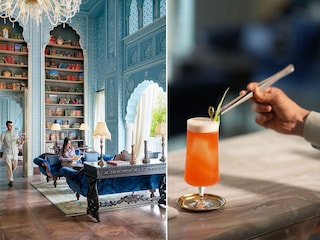Luxury food players bet big on India's appetite for fine things
Some of the world's most vaunted restaurants, bars and chefs are setting up outlets in the country as it becomes a hotspot for luxury dining and hospitality


It is an unusually wet autumn in the desert. As we drive into Jaipur, the Pink City now turned green, it is an ideal rainy day to stay ensconced inside a palace—albeit a modern one—and read a tome or two about glories gone by. At the Writers Bar tucked inside the new Raffles hotel that has just opened in the city, designed like a “modern maharani’s" palace, the setting is just right for a day of leisure. Plush bound classics and coffee table books on princely India compete for attention with a showpiece of a bar, and a winding, old-fashioned staircase that takes you up to a tasteful wine library. You sink into the art-deco couch, and begin to sip on a saffron-hued legacy liqueur from Rajasthan. Chandrahaas, the liqueur whose recipe goes back a few hundred years, was the exclusive elixir of the Katoch clan. It is flavoured with saffron and about 50-odd herbs and spices, part of a royal tradition of liqueurs or distilled “asav" (flavoured spirits) that each of the Rajput thikanas specialised in. Chandrahaas is similar to the much-vaunted Kesar Kasturi of the Jodhpur royals, and a cousin of others like Jagmohan, Manmohan, Mawali et al made from different family recipes of each of the aristocratic clans tracing allegiance to the erstwhile major princely states of Mewar, Marwar, Amber/Jaipur and others. The liqueurs were served to guests as a symbol of hospitality and to ostensibly promote vitality and protect against the cold or heat of the desert. At the historic Writers Bar that came up in the 19th century in Singapore, inspired by colonial men of literature such as Kipling and Conrad who visited the Straits, this touch of Indianism meets the inherent internationalism of the iconic bar.
Interestingly, we find a dash of chandrahaas also added to the Raffle’s best-known drink, the Singapore Sling—here, the Jaipur Sling—to sip on which throngs of tourists queue up daily at the Singapore hotel. In Jaipur, the French liqueur Benedictine (containing 20-plus herbs) part of the punch-like cocktail’s recipe has been substituted with the more complex Indian chandrahaas giving a delicious local twist to the classic. While Raffles Jaipur’s quintessential definition of luxury includes the idea of European decadence such as champagne breakfasts in suite, butler service and bespoke menus and is in sync with the values of its parent company, the French major Accor, it is remarkable for another reason too. Rajasthan is the only geographical area where two Raffles have opened in relatively close proximity (the Raffles Udaipur opened in 2021), signalling the fact that foreign luxury hospitality players are betting big on India’s appetite for fine things. While vaunted brands such as this are bringing in a sense of internationalism, India’s own traditions of luxury are also being rightfully entwined with the global aesthetic and taste.
Armani Caffe at the Jio World Plaza in Mumbai with its wine selection on display. The Beetroot Carpaccio on the menu.
Armani Caffe, for instance, the global super chic chain, known for its discerning patrons from Milan to Dubai, has just made its south Asia debut in Mumbai recently at the Jio World Plaza. It brings to the table the Armani aesthetic along with Italian gastronomy.
Food apart, the restaurant promises what is going to be perhaps the best selection of Italian wines in the country—not just the big labels but also niche regional selections. (The Italian wine culture is the most diverse in the world with a huge number of regional grape varieties and wine-making styles). As the well-heeled Indian customers learn to sip and admire the differences between an elegant Barbaresco from Piedmonte and a high-powered Amarone della Valpolicella, it is important to also note that historically India has struggled with not just a lack of choice when it came to a wide variety of international wines thanks to high duties but also because the market seemed never quite to come of age when it came to wine. A decade ago, as I had toured northern Italy—from Verona to Piedmonte, with a wine importer and a restaurateur-chef in tow, trying various regional wines to study what may suit the Indian market and palate, it had been deemed by the two businessmen by my side that the better quality, more elusive, and smaller labels would just not be commercially viable or acceptable in India. That has now changed with new aspiration and openness.
“Being an Indian, I always wanted to come to India…" she explains, adding that “most international companies are now looking at India because of its economy, spending power and the kind of dining experiences people are seeking post Covid. To be honest, a lot of markets are saturated internationally. Everyone wants to expand and they are looking at India," she says.
It"s an early lesson that many looking to India’s burgeoning appetite for fine foods and experiences may imbibe.
First Published: Oct 01, 2024, 10:03
Subscribe Now